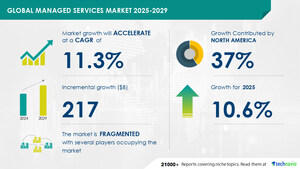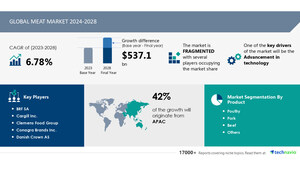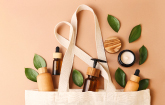NEW YORK, Sept. 19, 2024 /PRNewswire/ -- Report on how AI is redefining market landscape- The global antioxidant cosmetic products market size is estimated to grow by USD 22.43 billion from 2024-2028, according to Technavio. The market is estimated to grow at a CAGR of almost 8.09% during the forecast period. Product innovation and portfolio extension is driving market growth, with a trend towards growing popularity of private-label brands. However, growing price wars among market vendors poses a challenge. Key market players include Air Liquide SA, Archer Daniels Midland Co., Ashland Inc., Barentz International BV, BASF SE, BIOTECNOLOGIAS APLICADAS SL, Camlin Fine Sciences Ltd., Croda International Plc, Eastman Chemical Co., Evonik Industries AG, Givaudan SA, IMCD NV, Industrias Asociadas S.L., Koninklijke DSM NV, Lonza Group Ltd., LOreal SA, Merck KGaA, NATURAL SOLTER SL, Provital SA, and Wacker Chemie AG.
AI-Powered Market Evolution Insights. Our comprehensive market report ready with the latest trends, growth opportunities, and strategic analysis- View your snapshot now
Forecast period |
2024-2028 |
Base Year |
2023 |
Historic Data |
2018 - 2022 |
Segment Covered |
Distribution Channel (Offline and Online), Application (Skincare, Haircare, and Color cosmetics), and Geography (APAC, Europe, North America, South America, and Middle East and Africa) |
Region Covered |
APAC, Europe, North America, South America, and Middle East and Africa |
Key companies profiled |
Air Liquide SA, Archer Daniels Midland Co., Ashland Inc., Barentz International BV, BASF SE, BIOTECNOLOGIAS APLICADAS SL, Camlin Fine Sciences Ltd., Croda International Plc, Eastman Chemical Co., Evonik Industries AG, Givaudan SA, IMCD NV, Industrias Asociadas S.L., Koninklijke DSM NV, Lonza Group Ltd., LOreal SA, Merck KGaA, NATURAL SOLTER SL, Provital SA, and Wacker Chemie AG |
Key Market Trends Fueling Growth
Private-label antioxidant cosmetic products have gained significant attention among retailers worldwide, with major players introducing their brands to cater to the rising consumer demand. Retailers such as Ulta Beauty sell antioxidant skincare and color cosmetics under their private labels to boost profitability. Discount stores, focusing on value pricing, have fueled the growth of private labels, with key distribution channels including supermarkets, hypermarkets, drugstores, and online stores. Distributors are improving procurement processes and quality monitoring to meet consumer expectations. Ulta Beauty, a leading beauty retailer, offers antioxidant cosmetics like ULTA Liquid Illuminator and ULTA 24K Magic Beauty Oil, priced lower than branded alternatives, making them attractive to price-sensitive consumers. The increasing demand for private-label brands is expected to continue, supporting the growth of the global antioxidant cosmetic products market.
The Antioxidant Cosmetic Products market is witnessing significant growth due to the increasing demand for products that combat free radicals and oxidative stress. Doctors and dermatologists recommend antioxidant-rich cosmetics for various skin concerns such as acne, eczema, dryness, and wrinkles. Live bacteria and bacteria extracts are trending ingredients, as they support a balanced microbiome and improve skin health. Cosmetic manufacturers are incorporating natural antioxidants from fruits, herbs, spices, and animals into their formulations. Fragrance, color, and vitamins are popular product types in the antioxidant cosmetics segment. Online shopping is a preferred choice for consumers, but beware of counterfeit cosmetic products. Environmental effects, infection, itching, and other skin concerns are driving the demand for antioxidant-infused cosmetics. Regulatory requirements, compatibility, stability, and shelf life are crucial factors for cosmetic manufacturers. Synthetic and natural antioxidants offer varying benefits, and consumers seek out brands with recognized names and proven performance. Antioxidants improve appearance, texture, and protect against environmental damage. Skin care, hair care, and body care products all benefit from antioxidant ingredients.
Insights on how AI is driving innovation, efficiency, and market growth- Request Sample!
Market Challenges
- The antioxidant cosmetic products market is experiencing intense competition, with established players and new entrants vying for market share. Price wars among vendors represent a significant challenge, as some companies offer affordable antioxidant products to attract customers. For instance, L'Oreal's Garnier brand offers antioxidant skincare and haircare products starting at USD4 in the US. In response to this competition, various global vendors are expected to lower the prices of their antioxidant cosmetic products during the forecast period.
- The Antioxidant Cosmetic Products Market is thriving due to the increasing demand for make-up and body care items that provide anti-aging, anti-wrinkle, anti-inflammatory, and UV protection benefits. Butylated hydroxytoluene (BHT), Butylated hydroxyanisole (BHA), and Tert-butylhydroquinone (TBHQ) are common chemically derived antioxidants used in cosmetics. However, concerns over their safety and potential carcinogenic and allergic reactions have led to a shift towards natural antioxidants like vitamins, carotenoids, polyphenols, and enzymes. The aging population, skin diseases, hair fall, and sunspots are key drivers for the market. Consumers are also seeking premium skincare and hair care products to maintain their youthful appearance in the age of selfies and social media. Oxidation reactions caused by free oxygen radicals, pollution, and the aging process damage proteins and lipids in skin cells. Antioxidants neutralize these damaging agents, preventing oxidative stress and promoting healthy skin. Living standards and the young generation's focus on natural ingredients are also fueling the market growth. However, individual sensitivity and concentration levels of antioxidants are critical factors to consider for product development and safety.
Insights into how AI is reshaping industries and driving growth- Download a Sample Report
Segment Overview
This antioxidant cosmetic products market report extensively covers market segmentation by
- Distribution Channel
- 1.1 Offline
- 1.2 Online
- Application
- 2.1 Skincare
- 2.2 Haircare
- 2.3 Color cosmetics
- Geography
- 3.1 APAC
- 3.2 Europe
- 3.3 North America
- 3.4 South America
- 3.5 Middle East and Africa
1.1 Offline- The Antioxidant Cosmetic Products market is growing due to increasing consumer awareness about skin health and the benefits of antioxidants. Antioxidants neutralize free radicals, protecting the skin from damage. Companies are launching new products with antioxidant ingredients like vitamin C, vitamin E, and green tea extract. Consumers prefer these products for their anti-aging and skin brightening properties. The market is expected to continue growing, driven by rising demand and innovation in product offerings.
Download complimentary Sample Report to gain insights into AI's impact on market dynamics, emerging trends, and future opportunities- including forecast (2024-2028) and historic data (2018 - 2022)
Research Analysis
Antioxidant cosmetic products are formulations designed to neutralize free radicals and reduce oxidative stress, enhancing the appearance and texture of the skin. Free radicals are unstable molecules that can damage proteins, lipids, and skin cells, leading to signs of aging such as wrinkles, fine lines, and discoloration. Antioxidants, including vitamins C and E, fruits, herbs, and spices, are key ingredients in these products, as they can inhibit oxidation reactions caused by free oxygen radicals. Shelf life and performance are crucial factors in the development of antioxidant cosmetics, as well as regulatory requirements and environmental effects. These products offer benefits beyond appearance, including anti-inflammatory, anti-aging, UV protection, and moisturizing properties. Fragrance and brand recognition also play a role in consumer preference. Antioxidant cosmetics can protect against the harmful effects of pollution, infection, itching, and other environmental factors, making them an essential addition to any skincare routine.
Market Research Overview
Antioxidant cosmetic products have gained significant popularity in the beauty industry due to their ability to neutralize free radicals and combat oxidative stress. These cosmetics help maintain the appearance and texture of skin, hair, and other body parts by protecting against oxidation reactions caused by environmental factors, pollution, and the aging process. Antioxidants like Butylated hydroxytoluene (BHT), Butylated hydroxyanisole (BHA), Propyl Gallate (PG), Tert-butylhydroquinone (TBHQ), Vitamins, Carotenoids, Polyphenols, Enzymes, and others are used in various cosmetic products, including skin care, hair care, make-up, and body care. Regulatory requirements and compatibility with other ingredients are crucial factors in the production of antioxidant cosmetics. Synthetic antioxidants like BHT, BHA, and PG have been under scrutiny due to safety concerns, leading to a growing interest in natural antioxidants derived from plants, food sources, and live bacteria. Natural antioxidants offer several benefits, including anti-aging, anti-wrinkle, anti-inflammatory, and UV protection properties. The aging population, skin diseases such as acne, eczema, dryness, and wrinkles, and the increasing demand for premium skincare and natural ingredients are driving the growth of the antioxidant cosmetic market. The young generation's emphasis on selfies and social media has further fueled the demand for these products. However, individual sensitivity, allergic reactions, and the risk of counterfeit cosmetic products pose challenges to the industry. Environmental effects, infection, itching, and animal testing are other concerns that cosmetic manufacturers must address while developing antioxidant cosmetic products. The market for antioxidant cosmetics is expected to continue growing due to the increasing awareness of the importance of antioxidants in maintaining healthy skin, hair, and overall well-being.
Table of Contents:
1 Executive Summary
2 Market Landscape
3 Market Sizing
4 Historic Market Size
5 Five Forces Analysis
6 Market Segmentation
- Distribution Channel
- Offline
- Online
- Application
- Skincare
- Haircare
- Color Cosmetics
- Geography
- APAC
- Europe
- North America
- South America
- Middle East And Africa
7 Customer Landscape
8 Geographic Landscape
9 Drivers, Challenges, and Trends
10 Company Landscape
11 Company Analysis
12 Appendix
About Technavio
Technavio is a leading global technology research and advisory company. Their research and analysis focuses on emerging market trends and provides actionable insights to help businesses identify market opportunities and develop effective strategies to optimize their market positions.
With over 500 specialized analysts, Technavio's report library consists of more than 17,000 reports and counting, covering 800 technologies, spanning across 50 countries. Their client base consists of enterprises of all sizes, including more than 100 Fortune 500 companies. This growing client base relies on Technavio's comprehensive coverage, extensive research, and actionable market insights to identify opportunities in existing and potential markets and assess their competitive positions within changing market scenarios.
Contacts
Technavio Research
Jesse Maida
Media & Marketing Executive
US: +1 844 364 1100
UK: +44 203 893 3200
Email: [email protected]
Website: www.technavio.com/
SOURCE Technavio

WANT YOUR COMPANY'S NEWS FEATURED ON PRNEWSWIRE.COM?
Newsrooms &
Influencers
Digital Media
Outlets
Journalists
Opted In




Share this article